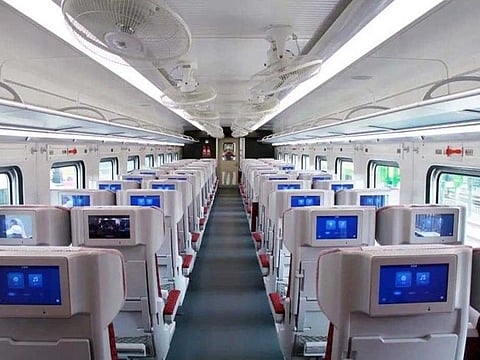Why Pakistan’s Lahore-Islamabad fast train is a vanity project
Punjab government’s $10 billion high-speed rail plan is a disservice to real priorities

In a country surviving upon largesse from some friends and international lenders, with a dismally low tax base and crippling debt obligations, the Punjab government’s recent Quixotic announcement of a proposal for an estimated $10 billion high-speed rail (HSR) line between Lahore and Islamabad is baffling.
Pakistan’s foreign exchange reserves are at about $10 billion, much of it borrowed sum, good for less than two months of imports. The idea of pouring billions into a vanity rail project, when schools, hospitals, and human development indicators are in decline, is a painful reminder of the disconnect between the country’s ruling elite and its actual needs.
The proposed HSR would cover a distance of 350km and cut travel time between the two cities to around two-and-a-half hours. But in reality, once access, check-in, and traffic around congested stations are factored in, driving between Lahore and Islamabad via the M-2 motorway remains faster, cheaper, and more convenient — especially in a car-oriented culture where door-to-door convenience matters more than rail speed.
Public debt
Pakistan’s public debt now exceeds PKR 80 trillion (approximately $285 billion), according to the State Bank of Pakistan. As of the fiscal year 2023–24, Pakistan’s tax revenues are insufficient to fully cover the interest payments on its public debt, highlighting a significant fiscal challenge. The tax-to-GDP ratio lingers under 10 percent, one of the lowest in the world. And yet, despite these fiscal limitations, in public profligacy the government appears ready to plunge into a $10 billion mega-project that benefits a fraction of the population.
This stands in stark contrast to the much-needed $6.678 billion ML-1 rail upgrade under the China Pakistan Economic Corridor (CPEC) — a project meant to revive Pakistan’s entire north-south railway backbone. The government has dragged its feet on ML-1, citing affordability concerns leaving the critical project languishing in the files for ten years. Yet, for a Lahore-Islamabad HSR, the purse strings seem oddly flexible. It begs the question: whose interests are being served?
This is not the first time this current political clique has pursued prestige projects with little regard for long-term viability. The Lahore Orange Line Metro Train, launched with fanfare and foreign loans, now operates at a loss, heavily subsidised by the government. Ridership has fallen short of projections, and operational costs far outweigh revenues.
Metro buses
The road-based metro buses in Lahore, Rawalpindi, and Multan tell a similar story — grand openings, political slogans, and years of financial haemorrhaging. These are not transport solutions; they are symbols. They deliver instant optics but burden future governments with perpetual maintenance and subsidy obligations.
The new HSR line will likely follow the same trajectory: a headline grabber in its launch, a fiscal liability thereafter.
The fundamental problem in Pakistan’s development paradigm is short-termism. Infrastructure is selected not for national integration or economic efficiency, but for political mileage. Rulers think in five-year terms; real development takes decades.
Human development — which includes education, healthcare, and skill-building — is neglected because it is “invisible.” It doesn’t yield ribbon-cuttings, billboard campaigns, or election slogans. Yet it is precisely what Pakistan needs. Nearly 23 million children are out of school. Over a third of the population lives in multidimensional poverty. Health indicators are dismal, especially for women and children.
UNDP index
Pakistan ranks 161 out of 191 countries on the UNDP Human Development Index — far behind Bangladesh and India. But while regional neighbours build knowledge economies and healthcare systems, Pakistan continues to build roads, trains, and motorways — often in areas where there’s not even a decent sidewalk.
The Lahore-Islamabad corridor is already among the best-served in the country. It doesn’t need another transport link. In contrast, vast regions like southern Punjab, interior Sindh, Balochistan, and Gilgit-Baltistan remain underserved — not just in infrastructure but in basic governance.
This is how Pakistan builds inequality into its infrastructure. HSR is not a unifying national venture; it is meant to be another feather in the cap of a ruling elite that continues to govern like a colonial aristocracy — disconnected, extractive, and unaccountable.
Shift in focus needed
If the government is serious about inclusive development, it should shift its focus away from populism and provide what truly matters for the growth of the nation. These are: quality education and teacher training to build a competitive future workforce; universal healthcare access, especially for women and children in rural areas; vocational and technical training programs to reduce unemployment; civic infrastructure — safe water, waste disposal and treatment systems, public transport, and sidewalks — that improves everyday lives; digital access and e-governance to empower citizens and improve service delivery.
Investment in human capital infuses stake in the country and that’s what build nations.
Pakistan therefore, doesn’t need another bullet train. It needs to lift millions out of poverty, bring its children into classrooms, and offer dignity and opportunity to its citizens. The proposed HSR will not solve these problems. It will merely gloss over them with borrowed money and a false sense of progress.
It is time to stop mistaking speed for direction. Real development does not come with faster trains, but with fairer priorities.
Sajjad Ashraf served as an adjunct professor at the Lee Kuan Yew School of Public Policy, National University of Singapore from 2009 to 2017. He was a member of the Pakistan Foreign Service from 1973 to 2008 and served as an ambassador to several countries.
Sign up for the Daily Briefing
Get the latest news and updates straight to your inbox



